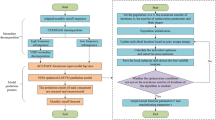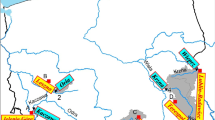Abstract
Accurate and reliable water quality forecasting is of great significance for water resource optimization and management. This study focuses on the prediction of water quality parameters such as the dissolved oxygen (DO) in a river system. The accuracy of traditional water quality prediction methods is generally low, and the prediction results have serious autocorrelation. To overcome nonstationarity, randomness, and nonlinearity of the water quality parameter data, an improved least squares support vector machine (LSSVM) model was proposed to improve the model’s performance at two gaging stations, namely Panzhihua and Jiujiang, in the Yangtze River, China. In addition, a hybrid model that recruits variational mode decomposition (VMD) to denoise the input data was adopted. A novel metaheuristic optimization algorithm, the sparrow search algorithm (SSA) was also implemented to compute the optimal parameter values for the LSSVM model. To validate the proposed hybrid model, standalone LSSVM, SSA-LSSVM, VMD-LSSVM, support vector regression (SVR), as well as back propagation neural network (BPNN) were considered as the benchmark models. The results indicated that the VMD-SSA-LSSVM model exhibited the best forecasting performance among all the peer models at Panzhihua station. Furthermore, the model forecasting results applied at Jiujiang were consistent with those at Panzhihua station. This result further verified the accuracy and stability of the VMD-SSA-LSSVM model. Thus, the proposed hybrid model was effective method for forecasting nonstationary and nonlinear water quality parameter series and can be recommended as a promising model for water quality parameter forecasting.









Similar content being viewed by others
Availability of data and material
All data generated or analyzed during this study are included in this published article.
References
Afshar, A., Shojaei, N., & Sagharjooghifarahani, M. (2013). Multiobjective calibration of reservoir water quality modeling using multiobjective particle swarm optimization (MOPSO). Water Resources Management, 27(7), 1931–1947. https://doi.org/10.1007/s11269-013-0263-x
Ahmed, A. N., Othman, F. B., Afan, H. A., Ibrahim, R. K., Fai, C. M., Hossain, M. S., & Elshafie, A. (2019). Machine learning methods for better water quality prediction. Journal of Hydrology, 578, 124084. https://doi.org/10.1016/j.jhydrol.2019.124084
Alizadeh, M. J., Kavianpour, M. R., Danesh, M., Adolf, J., Shamshirband, S., & Chau, K. W. (2018). Effect of river flow on the quality of estuarine and coastal waters using machine learning models. Engineering Applications of Computational Fluid Mechanics, 12(1), 810–823. https://doi.org/10.1080/19942060.2018.1528480
Barzegar, R., Adamowski, J., & Moghaddam, A. A. (2016). Application of wavelet-artificial intelligence hybrid models for water quality prediction: a case study in Aji-Chay River. Iran. Stochastic environmental research and risk assessment, 30(7), 1797–1819. https://doi.org/10.1007/s00477-016-1213-y
Chen, X. Y., & Chau, K. W. (2019). Uncertainty analysis on hybrid double feedforward neural network model for sediment load estimation with LUBE method. Water Resources Management, 33(10), 3563–3577. https://doi.org/10.1007/s11269-019-02318-4
Cheng, C. T., Niu, W. J., Feng, Z. K., Shen, J. J., & Chau, K. W. (2015). Daily reservoir runoff forecasting method using artificial neural network based on quantum-behaved particle swarm optimization. Water, 7(8), 4232–4246. https://doi.org/10.3390/w7084232
Choubin, B., Borji, M., Hosseini, F. S., Mosavi, A., & Dineva, A. A. (2020a). Mass wasting susceptibility assessment of snow avalanches using machine learning models. Scientific reports, 10(1), 1–13. https://doi.org/10.1038/s41598-020-75476-w
Choubin, B., Darabi, H., Rahmati, O., Sajedi-Hosseini, F., & Kløve, B. (2018). River suspended sediment modelling using the CART model: A comparative study of machine learning techniques. Science of the Total Environment, 615, 272–281. https://doi.org/10.1016/j.scitotenv.2017.09.293
Choubin, B., Hosseini, F. S., Fried, Z., & Mosavi, A. (2020b). Application of Bayesian Regularized Neural Networks for Groundwater Level Modeling. In 2020 IEEE 3rd International Conference and Workshop in Óbuda on Electrical and Power Engineering (CANDO-EPE) (pp. 000209-000212). IEEE. https://doi.org/10.1109/CANDO-EPE51100.2020.9337753
Dragomiretskiy, K., & Zosso, D. (2013). Variational mode decomposition. IEEE transactions on signal processing, 62(3), 531–544. https://doi.org/10.1109/TSP.2013.2288675
Duan, W., He, B., Chen, Y., Zou, S., Wang, Y., Nover, D., & Yang, G. (2018). Identification of long-term trends and seasonality in high-frequency water quality data from the Yangtze River basin. China. PloS One, 13(2), e0188889. https://doi.org/10.1371/journal.pone.0188889
Ehteram, M., Binti Othman, F., Mundher Yaseen, Z., Abdulmohsin Afan, H., Falah Allawi, M., Najah Ahmed, A., & El-Shafie, A. (2018). Improving the Muskingum flood routing method using a hybrid of particle swarm optimization and bat algorithm. Water, 10(6), 807. https://doi.org/10.3390/w10060807
Guo, T., He, W., Jiang, Z., Chu, X., Malekian, R., & Li, Z. (2019). An improved LSSVM model for intelligent prediction of the daily water level. Energies, 12(1), 112. https://doi.org/10.3390/en12010112
Kargar, K., Samadianfard, S., Parsa, J., Nabipour, N., Shamshirband, S., Mosavi, A., & Chau, K. W. (2020). Estimating longitudinal dispersion coefficient in natural streams using empirical models and machine learning algorithms. Engineering Applications of Computational Fluid Mechanics, 14(1), 311–322. https://doi.org/10.1080/19942060.2020.1712260
Kim, S. E., & Seo, I. W. (2015). Artificial Neural Network ensemble modeling with conjunctive data clustering for water quality prediction in rivers. Journal of Hydro-Environment Research, 9(3), 325–339. https://doi.org/10.1016/j.jher.2014.09.006
Kisi, O., & Parmar, K. S. (2016). Application of least square support vector machine and multivariate adaptive regression spline models in long term prediction of river water pollution. Journal of Hydrology, 534, 104–112. https://doi.org/10.1016/j.jhydrol.2015.12.014
Kisi, O., Choubin, B., Deo, R. C., & Yaseen, Z. M. (2019). Incorporating synoptic-scale climate signals for streamflow modelling over the Mediterranean region using machine learning models. Hydrological Sciences Journal, 64(10), 1240–1252. https://doi.org/10.1080/02626667.2019.1632460
Leong, W. C., Bahadori, A., Zhang, J., Ahmad, Z. (2019). Prediction of water quality index (WQI) using support vector machine (SVM) and least square-support vector machine (LS-SVM). International Journal of River Basin Management, 1–8. https://doi.org/10.1080/15715124.2019.1628030
Li Y., Wang S., Chen Q., & Wang X. (2020). A Comparative Study of Several New Swarm Intelligence Optimization Algorithms. Computer Engineering and Applications, 1-23. (in Chinese). https://doi.org/10.3778/j.issn.1002-8331.2006-0291
Liu, G., Shu, C., Liang, Z., Peng, B., & Cheng, L. (2021). A modified sparrow search algorithm with application in 3d route planning for UAV. Sensors, 21(4), 1224. https://doi.org/10.3390/s21041224
Mosavi, A., Golshan, M., Janizadeh, S., Choubin, B., Melesse, A. A., Dineva, A. A. (2020). Ensemble models of GLM, FDA, MARS, and RF for flood and erosion susceptibility mapping: a priority assessment of sub-basins. Geocarto International, 1–20. https://doi.org/10.1080/10106049.2020.1829101
Mosavi, A., Hosseini, F. S., Choubin, B., Taromideh, F., Ghodsi, M., Nazari, B., & Dineva, A. A. (2021). Susceptibility mapping of groundwater salinity using machine learning models. Environmental Science and Pollution Research, 28(9), 10804–10817. https://doi.org/10.1007/s11356-020-11319-5
Nash, J. E., & Sutcliffe, J. V. (1970). River flow forecasting through conceptual models part I—A discussion of principles. Journal of hydrology, 10(3), 282–290. https://doi.org/10.1016/0022-1694(70)90255-6
Shamshirband, S., Jafari Nodoushan, E., Adolf, J. E., Abdul Manaf, A., Mosavi, A., & Chau, K. W. (2019). Ensemble models with uncertainty analysis for multi-day ahead forecasting of chlorophyll a concentration in coastal waters. Engineering Applications of Computational Fluid Mechanics, 13(1), 91–101. https://doi.org/10.1080/19942060.2018.1553742
Silva, H. A. N., Rosato, A., Altilio, R., & Panella, M. (2018). Water quality prediction based on wavelet neural networks and remote sensing. In 2018 International Joint Conference on Neural Networks, 1–6. IEEE. https://doi.org/10.1109/IJCNN.2018.8489662
Sun, W., Liu, M., & Liang, Y. (2015). Wind speed forecasting based on FEEMD and LSSVM optimized by the bat algorithm. Energies, 8(7), 6585–6607. https://doi.org/10.3390/en8076585
Tan, G., Yan, J., Gao, C., & Yang, S. (2012). Prediction of water quality time series data based on least squares support vector machine. Procedia Engineering, 31, 1194–1199. https://doi.org/10.1016/j.proeng.2012.01.1162
Tikhamarine, Y., Souag-Gamane, D., Ahmed, A. N., Kisi, O., & El-Shafie, A. (2020). Improving artificial intelligence models accuracy for monthly streamflow forecasting using grey Wolf optimization (GWO) algorithm. Journal of Hydrology, 582, 124435. https://doi.org/10.1016/j.jhydrol.2019.124435
Tung, T. M., & Yaseen, Z. M. (2020). A survey on river water quality modelling using artificial intelligence models: 2000–2020. Journal of Hydrology, 585, 124670. https://doi.org/10.1016/j.jhydrol.2020.124670
Wang, H., & Hu, D. (2005). Comparison of SVM and LS-SVM for regression. In 2005 International Conference on Neural Networks and Brain, 1, 279–283. IEEE. https://doi.org/10.1109/ICNNB.2005.1614615
Wu, Q., & Peng, C. (2015). Wind power grid connected capacity prediction using LSSVM optimized by the bat algorithm. Energies, 8(12), 14346–14360. https://doi.org/10.3390/en81212428
Xiang, Y., & Jiang, L. (2009). Water quality prediction using LS-SVM and particle swarm optimization. In 2009 Second International Workshop on Knowledge Discovery and Data Mining, 900–904. IEEE. https://doi.org/10.1109/WKDD.2009.217
Xue, J., & Shen, B. (2020). A novel swarm intelligence optimization approach: sparrow search algorithm. Systems Science & Control Engineering, 8(1), 22–34. https://doi.org/10.1080/21642583.2019.1708830
Xue, X. (2017). Prediction of slope stability based on hybrid PSO and LSSVM. Journal of Computing in Civil Engineering, 31(1), 04016041. https://doi.org/10.1061/(ASCE)CP.1943-5487.0000607
Xue, X. (2018). Evaluation of concrete compressive strength based on an improved PSO-LSSVM model. Computers and Concrete, 21(5), 505–511. https://doi.org/10.12989/cac.2018.21.5.505
Yan, Z., Sha, J., Liu, B., Tian, W., & Lu, J. (2018). An ameliorative whale optimization algorithm for multi-objective optimal allocation of water resources in Handan. China. Water, 10(1), 87. https://doi.org/10.3390/w10010087
Yaslan, Y., & Bican, B. (2017). Empirical mode decomposition based denoising method with support vector regression for time series prediction: A case study for electricity load forecasting. Measurement, 103, 52–61. https://doi.org/10.1016/j.measurement.2017.02.007
Yuan, J., Zhao, Z., Liu, Y., He, B., Wang, L., Xie, B., & Gao, Y. (2021). DMPPT Control of Photovoltaic Microgrid Based on Improved Sparrow Search Algorithm. IEEE Access, 9, 16623–16629. https://doi.org/10.1109/ACCESS.2021.3052960
Yin, S., Wu, Y., Xu, W., Li, Y., Shen, Z., & Feng, C. (2016). Contribution of the upper river, the estuarine region, and the adjacent sea to the heavy metal pollution in the Yangtze Estuary. Chemosphere, 155, 564–572. https://doi.org/10.1016/j.chemosphere.2016.04.095
Zhao, X. H., & Chen, X. (2015). Auto regressive and ensemble empirical mode decomposition hybrid model for annual runoff forecasting. Water Resources Management, 29(8), 2913–2926. https://doi.org/10.1007/s11269-015-0977-z
Zhou, Y. (2020). Real-time probabilistic forecasting of river water quality under data missing situation: Deep learning plus post-processing techniques. Journal of Hydrology, 589, 125164. https://doi.org/10.1016/j.jhydrol.2020.125164
Zhu, Y., & Yousefi, N. (2021). Optimal parameter identification of PEMFC stacks using Adaptive Sparrow Search Algorithm. International Journal of Hydrogen Energy, 46(14), 9541–9552. https://doi.org/10.1016/j.ijhydene.2020.12.107
Acknowledgements
The authors would like to thank the editors and anonymous reviewers for their constructive comments that greatly contributed to improving the manuscript.
Author information
Authors and Affiliations
Corresponding authors
Ethics declarations
Conflict of interest
The authors declare no competing interests.
Additional information
Publisher's Note
Springer Nature remains neutral with regard to jurisdictional claims in published maps and institutional affiliations.
Rights and permissions
About this article
Cite this article
Song, C., Yao, L., Hua, C. et al. A water quality prediction model based on variational mode decomposition and the least squares support vector machine optimized by the sparrow search algorithm (VMD-SSA-LSSVM) of the Yangtze River, China. Environ Monit Assess 193, 363 (2021). https://doi.org/10.1007/s10661-021-09127-6
Received:
Accepted:
Published:
DOI: https://doi.org/10.1007/s10661-021-09127-6




